By Mike Smith
In my neck of the woods, soccer is still growing. Our state high school athletic association just 5 years ago re aligned the soccer districts and regions to match the basketball districts and regions. This was to help maintain traditional rivalries as the number of schools with soccer programs had almost caught up to the number of schools with basketball programs ( which in Kentucky is every one of them ). With this growth however, comes what I call an overall “ football mentality” ( American Football )on the part of many of the young, newer players.
The main hallmark of this football mentality is the propensity of the players to want to always go forward, even if the way forward is through the shin guards of 6 opposing players. Something I have used to help players understand that in soccer forward is not always better is the idea of Positive and Negative Space. I simplify this a bit for them and just ask them to understand that with every pass they make or receive ( the positive ) there was something happening behind them ( the negative ). Almost every player on or near the ball will always have both a forward ( positive ) and backward ( negative ) option.
This really helps young players to start looking for combinations as far as passing and I even encourage my dribblers to utilize negative space on the dribble as this will often pull defenders way out of position. ( now if I could just get my dribblers to pass…….) Understanding positive and negative space will help your players and team in many areas, and if you have never covered it with them, try implementing it into your system.
Below the left mid has the ball wide, with the standard support a 4-4-2 shape provides. A play down the wing is always a safe bet, however, a bit of forward thinking will show the attack soon to be in a closed down space and numbers down.
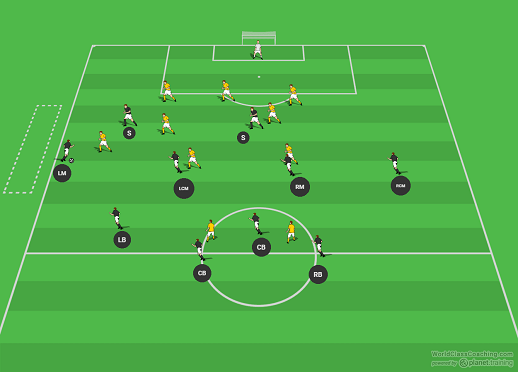
The red arrows show the recovery runs by the defense which will provide numbers up and restrict attacking space if the forward option is the only one used here.
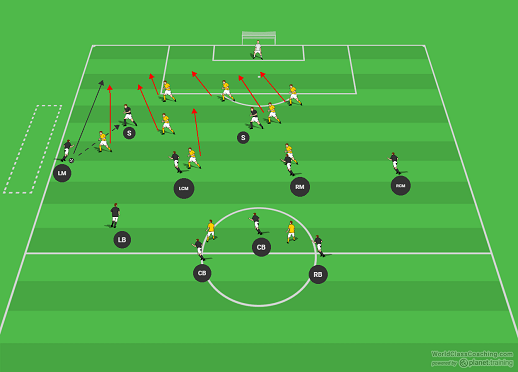
Below, the benefits of using the negative space are clear. Lets say this is 20 minutes into the game and the attacking side has forced everything up the line thus far. It is likely the defense will assume once the pass goes into the striker for the give and go, that the left mid will get the ball back wide at the end of an aggressive run. However, look at what is waiting in the negative space.
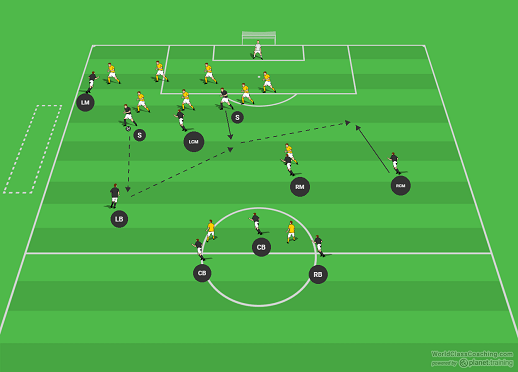
A good switch out by dropping the ball back will either equal an open run deep into the box, or, as shown below in red, a chance to burn the defense for over correcting by sending the ball once again into the space they just left. I would argue even though this space ( in red on the back side ) is not backward per say, it is behind the direction of the ball and is in essence, negative.
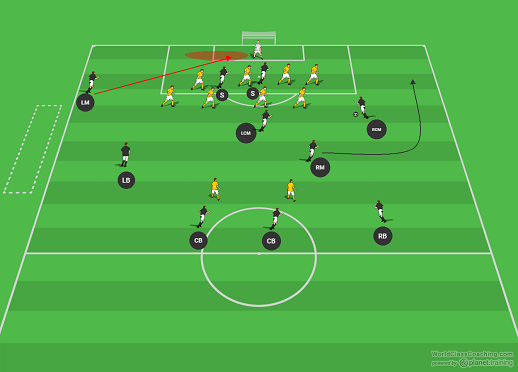
Its almost as simple as playing the ball where the opponent isn’t, but using positive and negative space effectively depends on utilizing both to keep your opponent on their toes. Try this at your next practice to get your players seeing the benefits of using the negative space.
Set Up
4 attacking players take on 3 defending players in two grids on the left side of the field ( as shown below ). The entire grid should be approx. 30 yds wide and 40 yds deep, but must be divided into two sections. Play starts in the bottom section where 3 attackers take on 1 defender. The additional attacker and two defenders in the top section must stay until all attackers in the bottom section have touched the ball. When this happens, one attacker runs across the field to a gate marked by cones ( as shown ) to serve as a target. Now 3 v 3 in the box, once the added attacker has touched the ball, the attacking team may serve the ball across to the attacker in the gate, but the attacking team must do this under pressure from the defending team. Attackers score by hitting the 4th attacker through the gate, defenders score by making 5 passes inside the box. Additional groups of 3 then rotate in.
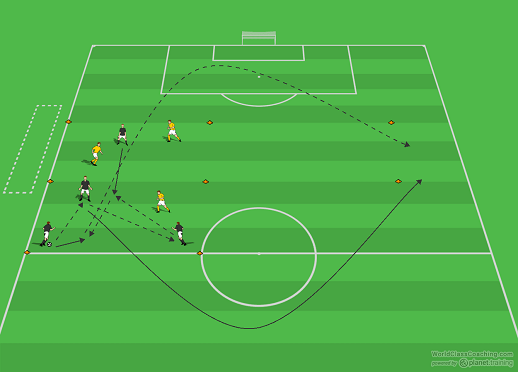
Progression
Add a keeper and allow the attacking players to go to goal, while the defenders try to recover once the ball is served through the gate. The service must come from the player waiting in the gate.
Coaching Points
The players will have to use the positive and negative space to make this work. The coach should make sure the players are moving and combining and seeing the correct options , both positive and negative.
By Mike Smith
Currently the Head Coach for University Heights Academy Boys Soccer in Hopkinsville, KY , Mike is in his 14th year as a high school head coach with 23 years coaching experience overall and 34 year as a student and fan of the game. He holds a USSF D License.


